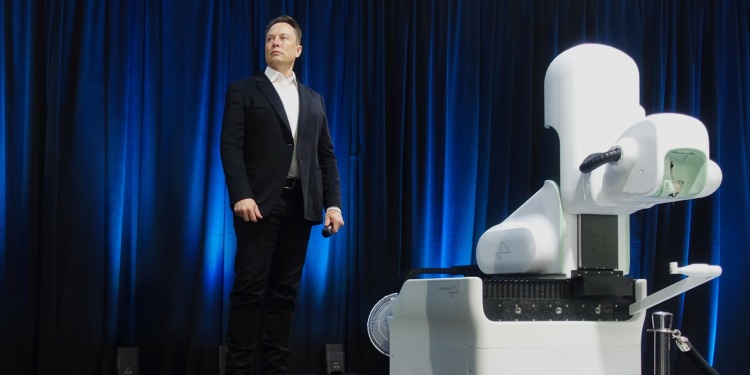Elon Musk gave a progress report about his neuroscience startup Neuralink at a streamed event on Wednesday evening, where he stated that Neuralink hopes to begin human trials for its brain implant within six months. However, Musk has already pushed back this six-month timeline multiple times, and brain-implant technology is already being trialled on humans by other startups.
So, what is holding up FDA approval for Neuralink? Did Musk demonstrate any meaningful progress towards this on Wednesday or was the event simply a demonstration of Musk’s own concern that he will lose the race for the first commercially available brain-implant technology?
How will Neuralink work?
In Neuralink’s own words, their aim is “developing ultra high bandwidth brain-machine interfaces to connect humans and computers.”
The basic idea relies on the fact that computers and brains communicate through the same basic mode: electricity. A series of electric pulses or signals is the basic operating language of both brains and modern computing machines.
The challenge of connecting these two is multifaceted. The first problem lies in being able to physically sense and capture the complex patterns of electric impulses that form thoughts or actions in a human brain. The brain fires trillions of electric impulses every second, and the discussion about the best way of capturing as many of these impulses as possible, or even how many are necessary, is ongoing.
Additionally, the brain itself is a delicate and sensitive organ; figuring out how to insert physical electrodes to “read” these signals without interrupting or damaging the brain’s processes is central to the success of this technology.
Then, there’s a translation problem; an implant has to interpret a brain’s organic electrical signals and convert them into a separate set of electric signals that a computer can understand.
However, the basics of these problems have been solved already, to varying degrees of sophistication. Most of the technology that Neuralink uses is already well-established and used often for medical purposes.
Electric neural activity is already being monitored through electrodes that are placed either externally, i.e. on the scalp, or internally, i.e. inside the brain. This process is called an electroencephalogram (EEG) and has a wide range of medical applications. It is mostly used to determine neural disorders, including epilepsy and brain damage.
Translating brain signals into data that can be interpreted by a computer, technology that is broadly referred to as brain-computer interface or BCI, is also already possible, although it is likely still in its infancy.
BCIs have been used for ground-breaking medical purposes, including allowing people who have been paralyzed to interface with tablets or even to walk again, an act made possible by powering robotic prosthetics with their mind. It has also been used outside of hospitals for recreational purposes, like flying drones.
Neuralink and other similar projects like Synchron, Neurable, and Emotiv are harnessing all of these technologies in tandem, in the hopes of allowing users to wirelessly control mobile devices and computers by thought alone.
The Neuralink device itself has dozens of thin wires which would thread through the user’s brain tissue in order to collect electric signals. These probes physically attach and feed back to the “Link”, which is the implanted device that both translates the neuronal spikes into data interpretable by a computer and wirelessly broadcasts that data outside of the human body to a machine.
Neuralink and other similar technologies rely on a combination of individual technologies that have existed for a while – EEG, BCI, and the basics of wireless signal transmission. However, nobody has successfully been able to demonstrate that a semi-permanent implant in the human brain will be able to function for a long time with a high level of precision without negatively affecting the device, or more importantly, the brain.
FDA Approval
The long-term presence of electrodes in human brain tissue has been shown to be problematic and harmful to brain health and function.
In the short-term, inserting the electrodes always poses a risk of damaging delicate brain tissue.
Related Articles: Should Robots Be Built to Feel Pain? | Tesla Autopilot Crashes: With at Least a Dozen Dead, ‘Who’s at Fault, Man or Machine?’
The insertion of the Neuralink device is done by means of a robot because the probe threads are too delicate for a human hand to manoeuvre. It also involves removing and replacing a chunk of skull in order to insert the probes and the Link.
This procedure is more invasive than most of Neuralink’s competitors, but Musk has claimed that this, combined with greater computing capabilities, will aid the hardware in achieving better results and restoring more functions than its competitors.
Semi-permanent brain implants have also been proven to cause damage after time. Brain cells recognise the electrodes as foreign bodies, which initiates an immune system response that causes the cells to become inflamed and eventually die. This not only affects the usefulness of the technology – it stops working when the neurons around the sensors stop working – but it also negatively affects the health of the brain.
The inflammatory response of brain tissue to long-term electric implantations has been described as “one of the most important obstacles to overcome in order for neural interface technology to be fully realized.”
One of Neuralink’s main competitors is Synchron, a venture-backed “brain data transfer company” based in New York. To Musk’s likely dismay, Synchron received FDA approval for an early feasibility study (EFS) in July 2021.
When it was announced that Synchron had beaten Neuralink to FDA approval, Musk reportedly approached Synchron to discuss potential investment in the company, frustrated by the slow progress at Neuralink.
Turning point today in the clinical translation of BCIs from lab to clinic. Synchron receives first company-sponsored FDA approval (IDE) to commence a clinical trial of a permanently implantable BCI for paralysis. No open brain surgery required. https://t.co/ioAaUbstUE
— Thomas Oxley (@tomoxl) July 28, 2021
One of the main reasons that Synchron beat Neuralink to this milestone is that they provided an alternative to inserting electrodes directly into brain tissue.
Synchron’s device hopes to bypass the issue of inflaming and damaging neurons by inserting electric probes through the brain’s blood vessels. By using the vascular system, Synchron’s device insertion takes place in a two-hour, minimally invasive procedure that resembles a stent placement and can be done in any angiography suite.
Nonetheless, Elon Musk announced on Wednesday that Neuralink has initiated the process of applying for an FDA-approved human clinical trial and hopes to implant a Neuralink device in a patient within six months. However, it is worth nothing that he has made similarly optimistic claims in the past before pushing back his own self-imposed deadlines:
Neuralink is working super hard to ensure implant safety & is in close communication with the FDA. If things go well, we might be able to do initial human trials later this year.
— Elon Musk (@elonmusk) February 1, 2021
Updates about Neuralink’s brain implant for humans:
Besides announcing his intention for an FDA-approved human clinical trial for Neuralink’s brain implant, Musk discussed a few other possible advances at Neuralink on Wednesday.
Most notably perhaps was the company’s intention to develop and roll out other implants alongside the Link. Musk revealed that implants had been developed for a severed spinal cord which could potentially restore movement in someone suffering from paralysis and an ocular implant that could improve or restore human vision.
Of these developments, he said:
“As miraculous as that may sound, we are confident that it is possible to restore full-body functionality to someone who has a severed spinal cord, [and] even if they’ve never seen before, we’re confident that they could see.”
On the whole, the presentation has been described as basically showing off “a grab bag of improvements”, and it was hard to tell what exactly was being demonstrated at the “show & tell” event.
As always, Musk laid out a lot of ambition and a few possible steps that could be made, but very little of what was shown on-screen was ground-breaking or different from what Neuralink and other similar technologies have already achieved.
Musk even reused an old video of a Macaque monkey playing Pong by means of Neuralink technology as part of his demonstration. The original video was first released in April 2021.
https://www.youtube.com/watch?v=rsCul1sp4hQ
The team at Neuralink did speak to the issue of inflammation during the Q&A session at the end of the event. Concerning the safety of the electrode implants themselves, they said:
“[We are] actively working on having some sort of biological coating to either reduce inflammation or make [the threads] slippery [and are] looking at kind of incorporating some of the learnings from biology and these coatings into our threads so that we can hopefully reduce inflammation…We’re also continuing to reduce the size of the electrode, so…scar tissue becomes minuscule. It’s like a very very tiny electrode the body basically ignores.”
However, there was no detail about whether these attempts to limit inflammation and damage to the brain have been trialled successfully.
The event held by Musk seemed more like a symbol of growing desperation than a demonstration of real progress. Rather than announcing concrete plans to fix the aspects of Neuralink that are of concern to the FDA, namely the invasive, robot-conducted surgery and the health risks of long-term electrode implants, Musk himself simply announced that he had come up with some cool ways for his still-hypothetically-safe technology to be used.
By the end, observers were left wondering what made Musk renew his hope again that Neuralink’s brain implant would finally receive FDA approval for human trials within six months.
Editor’s Note: The opinions expressed here by the authors are their own, not those of Impakter.com — In the Featured Photo: A photo of the first progress update from Musk about possible FDA approval of human trials for Neuralink’s brain implant in August 2020. Featured Photo Credit: Wikimedia.










